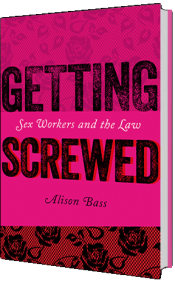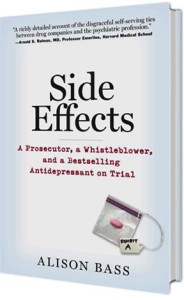I went to see Steven Soderbergh’s new film, Side Effects, with anticipation and dread. The movie, after all, carries the same name as my 2008 book, Side Effects and from what I could tell of the trailers, its plot seemed loosely based on the issue I explore in my book: the sometimes dangerous effects of antidepressant drugs. Soderbergh’s film turns out to be a cleverly done thriller with lots of twists and turns, but it is clearly not based on reality – either the reality of mental illness or the reality I expose in my book about how drug companies hid the negative effects of antidepressants. What the film does get right (but only touches on tangentially) is the extent to which drug companies lure doctors into selling their souls in return for lucrative consulting gigs to promote their drugs.
The plot line is this: Emily, a young woman with a previous history of depression tries to kill herself after her husband (the hunky Channing Tatum) is released from prison after serving four years for insider trading. Her new psychiatrist, the appropriately named Dr. Banks (ably played by Jude Law) prescribes an antidepressant in the class known as selective serotonin reuptake inhibitor (SSRIs), which includes Prozac, Zoloft, Paxil, and Celexa. The drug (we aren’t told which SSRI she gets) makes Emily nauseous and deprives her of her sex drive (both actual side effects of SSRIs), and Emily asks if she can take another new antidepressant she has heard about, the fictitious Ablixa. The new drug causes Emily to sleep walk and after a few weeks on it, she stabs her husband to death, ostensibly while she is sleepwalking. Right here, the movie departs from reality, since sleepwalking is not a common side effect of any SSRI that I am aware of; it is, however, a dangerous side effect of sleeping pills like Ambien and Lumina.
As the plot thickens and Emily (played with haunting intensity by Rooney Mara) goes on trial for the murder of her husband, it seems as though the movie is going to be a screed against doctors who prescribe potent drugs without knowing their side effects. At one point, one of Banks’ colleagues even mentions the black box warnings put on antidepressants by the FDA to warn people about the increased risk of suicidal thoughts and behaviors in young people. But in another break from reality, Banks appears to never have heard of these warnings. I found this implausible since the 2004-2005 warnings received so much publicity (both for and against the FDA’s decision) that any semi-conscious psychiatrist practicing in New York would have known about them. At any rate, Emily is declared not guilty by reason of insanity (because of the sleepwalking) and remanded to a local psychiatry hospital, where she is assured by her psychiatrist and lawyer that she will be released as soon as they deem her no longer dangerous to herself or others.
Here is where the plot starts turning. Banks’ reputation has been tarnished by all the publicity over the trial, his partners no longer want him in their practice and even the New York medical board is investigating him. At the same time, Banks begins to believe that Emily is lying about how and why she killed her husband. Here Soderbergh rachets up the drama by bringing to light an earlier case in which a mentally ill patient of Banks accused him of sexually abusing her. These accusations turn out to be false but they are enough to seed doubt in Banks’ wife about his integrity. (The movie takes another page from my book with this plot turn, since one of the real psychiatrists I profile was falsely accused of sexual misconduct by a troubled female patient). So when compromising pictures hinting at a sexual relationship between Banks and Emily are sent to his wife, that’s enough to provoke her into taking their young son and leaving him. That’s when Banks realizes he is being framed and it is up to him to solve the mystery of why Emily really killed her husband.
I don’t want to spoil the ending for those of you who haven’t seen the film; suffice it to say that the plot twists from here on in strain credulity. I found it very hard to believe, for instance, that Emily’s previous psychiatrist, played by the ever beautiful and indomitable Catherine Zeta-Jones, would be stupid or desperate enough to have sex with a female patient and then get involved in a plot to kill for money. (I covered many cases of sexual abuse by psychiatrists when I was mental health reporter for The Boston Globe and none of them involved a woman having sex with her patient). In addition, it is exceedingly unusual for a woman, even a very troubled one, to kill her spouse for money; the vast majority of women kill their husbands after years of physical and/or psychic abuse. But what I found myself most disappointed by was Soderbergh’s unwillingness to tackle head-on what should have been the heart of this story: the dangers posed by a medical-industrial complex that sometimes cares more about profit than it does about patient safety.
This blog was originally published under my byline on The Huffington Post.



Good movie review; detailed enough to convince me not to see the film.
Thanks! I’m not trying to discourage people from seeing the film, just trying to sort out the facts from the fiction.